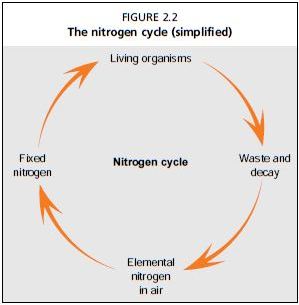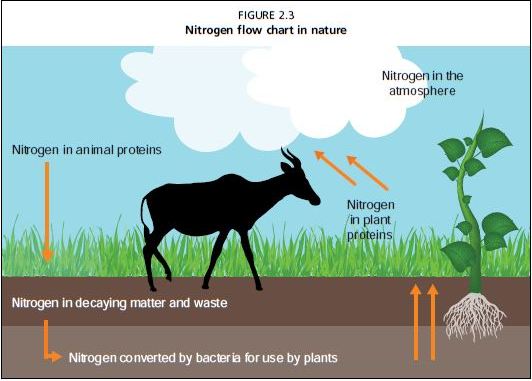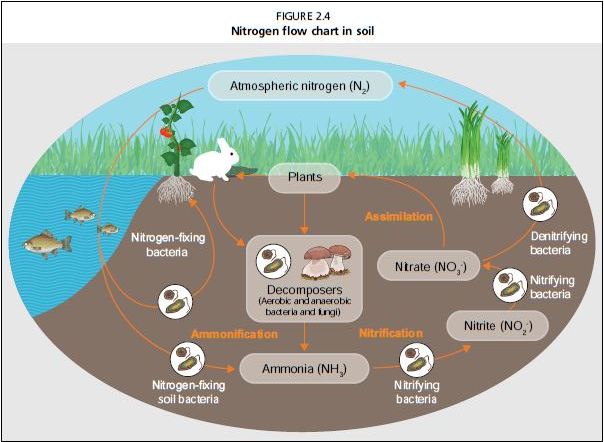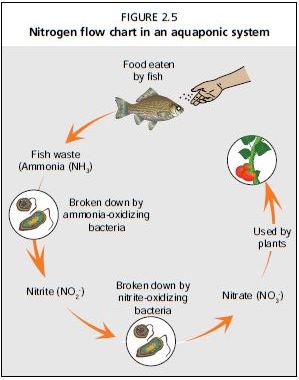2.1 IMPORTANT BIOLOGICAL COMPONENTS OF AQUAPONICS
As described in Chapter 1, aquaponics is a form of integrated agriculture that combines two major techniques, aquaculture and hydroponics. In one continuously recirculating unit, culture water exits the fish tank containing the metabolic wastes of fish. The water first passes through a mechanical filterthat captures solid wastes, and then passes through a biofilter that oxidizes ammonia to nitrate. The water then travels through plant grow beds where plants uptake the nutrients, and finally the water returns, purified, to the fish tank (Figure 2.1). The biofilter provides a habitat for bacteria to convert fish waste into accessible nutrients for plants.
These nutrients, which are dissolved in the water, are then absorbed by the plants. This process of nutrient removal cleans the water, preventing the water from becoming toxic with harmful forms of nitrogen (ammonia and nitrite), and allows the fish, plants, and bacteria to thrive symbiotically. Thus, all the organisms work together to create a healthy growing environment for one another, provided that the system is properly balanced.
FIGURE 2.1
The biological components in the aquaponic process: fish, plants and bacteria

2.1.1 The nitrogen cycle
The most important biological process in aquaponics is the nitrification process, which is an essential component of the overall nitrogen cycle seen in nature. Nitrogen (N) is a chemical element and an essential building block for all life forms. It is present in all amino acids, which make up all proteins which are essential for many key
FIGURE 2.2
The nitrogen cycle (simplified)

biological processes for animals such as enzyme regulation, cell signalling and the building of structures. Nitrogen is the most important inorganic nutrient for all plants. Nitrogen, in gas form, is actually the most abundant element present in the Earth's atmosphere making up about 78 percent of it, with oxygen only making up 21 percent. Yet, despite nitrogen being so abundant, it is only present in the atmosphere as molecular nitrogen (N2), which is a very stable triple bond of nitrogen atoms and is inaccessible to plants. Therefore, nitrogen in its N2 form has to be changed before plants use it for growth. This process is called nitrogen-fixation. It is part of the nitrogen cycle (Figure 2.2), seen throughout nature (Figure 2.3). Nitrogen- fixation is facilitated by bacteria that chemically alter the N2 by adding other elements such as hydrogen or oxygen, thereby creating new chemical compounds such as ammonia (NH3) and nitrate (NO3) that plants can easily use. Also, atmospheric nitrogen can be fixed through an energy-intensive manufacturing process known as the Haber Process, used to produce synthetic fertilizers.
The animal represented in Figure 2.3 produces waste (faeces and urine) that is largely made of ammonia (NH3). Other decaying organic matter found in nature, such as dead plants or animals, is broken down by fungi and different bacteria groups into ammonia. This ammonia is metabolized by a specific group of bacteria, which is very important for aquaponics, called nitrifying bacteria. These bacteria first convert the ammonia into nitrite compounds (NO2) and then finally into nitrate compounds (NO3). Plants are able to use both ammonia and nitrates to perform their growth processes, but nitrates are more easily assimilated by their roots.
FIGURE 2.3 Nitrogen flow chart in nature

FIGURE 2.4
Nitrogen flow chart in soil

FIGURE 2.5
Nitrogen flow chart in an aquaponic system

Nitrifying bacteria, which live in diverse. environments such as soil, sand, water and air, are an essential component of the nitrification process that converts plant and animal waste into accessible nutrients for plants. Figure 2.4 shows the same process as that illustrated in Figure 2.3, but includes a more complex flow chart showing all the stages of the nitrogen. cycle.
This natural process of nitrification by bacteria that happens in soil also takes place in water in the same way. For aquaponics, the animal wastes are the fish excreta released in the culture tanks. The same nitrifying bacteria that live on land will also naturally establish in the water or on every wet surface, converting ammonia from fish waste into the easily assimilated nitrate for plants to use. Nitrification in aquaponic systems provides nutrients for the plants and eliminates ammonia and nitrite which are toxic (Figure 2.5).